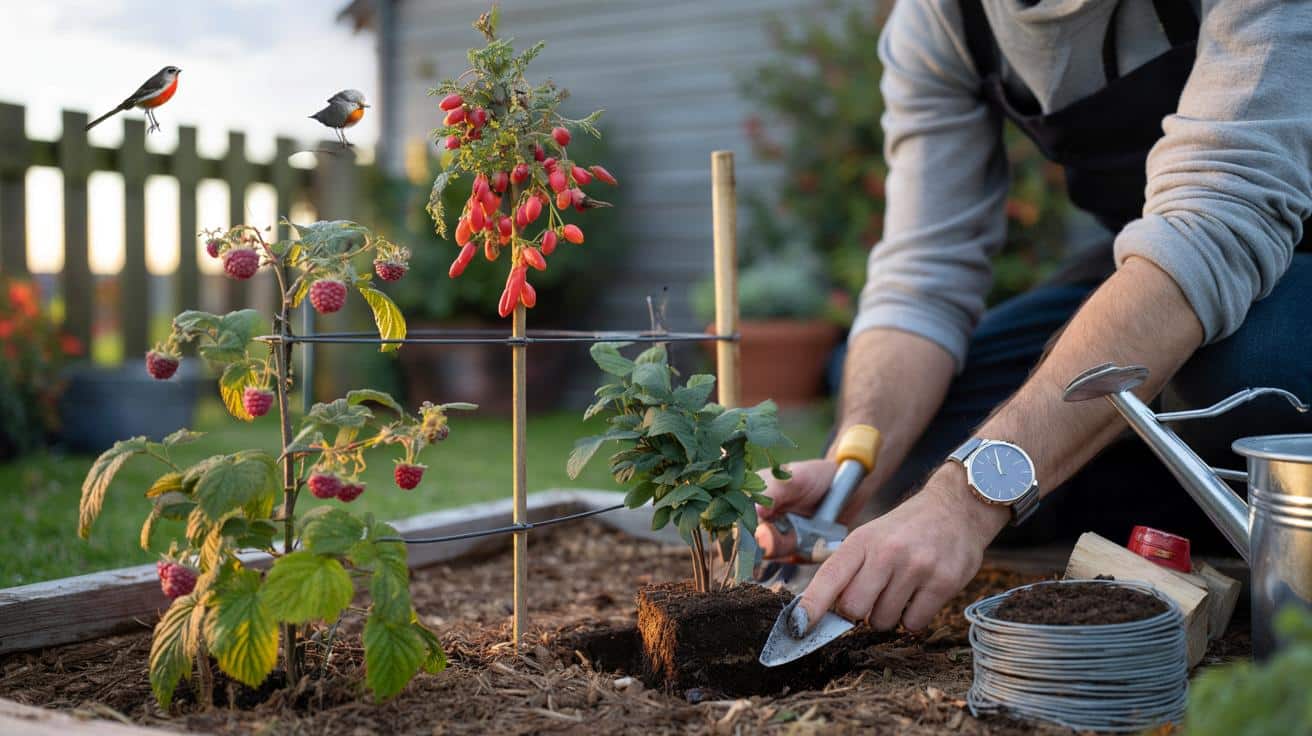As leaves turn, raspberries and goji step forward with quiet confidence. Planting them now takes little time, yet the rewards spread across plates, lunchboxes and bird feeders for months.
Two small fruiting shrubs that shake up autumn
Raspberries and goji: modest names, big late-season payoff
Autumn-fruiting raspberries and goji berries rarely headline garden plans, yet both can flood a small space with fruit when most beds look tired. Many modern raspberry cultivars fruit strongly from late summer into October, while goji, a tough hedgerow shrub in its Asian homeland, carries bead-like orange berries until the first hard frosts. Their habit suits tiny plots and balconies, and their roots handle British winters without fuss.
Give them sun, drainage and a light mulch, and you can pick from October every year with minimal upkeep.
Why October changes the game
Soil still holds warmth while air temperatures ease off, a sweet spot for new roots. Plant in October and the root system builds for 6–8 weeks before true dormancy. Spring growth then surges earlier than spring-planted stock, often bringing the first meaningful picking in year one for raspberries and by year two for goji.
One calm hour now can return 2–5 kg of fruit next year, plus a live larder for garden birds.
Plant in October for a running start
How to plant before the first frosts
Choose a bright site with shelter from prevailing wind. Work the soil 20–25 cm deep, remove perennial weeds and lay a 3–5 cm compost layer. Aim for a pH of 5.5–6.5 for raspberries; goji tolerates slightly alkaline ground up to around pH 8. Firm plants at the same depth as the nursery pot, water in well, then mulch with leafmould, wood chips or straw.
- Spacing: raspberries 45–60 cm between plants; 1.5–2 m between rows. Goji 1–1.5 m between plants.
- Containers: 30–40 litre pots for raspberries; 35–50 litres for goji. Ensure generous drainage holes.
- Watering target: 20–25 mm a week in dry spells; keep mulch topped up to 5 cm.
- Support: two wires or a trellis for raspberries to lift canes; a simple stake for young goji.
| Crop | Sun | Soil and pH | Yield when established | Time to first crop | Key pruning | Bird appeal |
|---|---|---|---|---|---|---|
| Autumn raspberries | Full sun or light shade | Moist, well-drained; pH 5.5–6.5 | 1–3 kg per plant per season | Often year one | Cut all canes to ground in late winter | High, especially in October |
| Goji (Lycium barbarum) | Full sun | Free-draining; pH 6.5–8.0 tolerated | 0.5–2 kg per mature bush | Usually year two | Open centre; thin weak whips in late winter | Moderate to high as berries colour |
No fuss, big harvests
Quick care that actually pays
These shrubs thrive on light-touch care. Keep weeds down with mulch. Water deeply during fruit swell, not daily sips. Feed with compost in spring; avoid high-nitrogen fertiliser that drives leafy growth at the expense of fruit. For raspberries, cutting all canes to ground each February keeps the patch clean and productive. For goji, remove crossing stems, shorten long laterals to 4–5 buds, and keep an airy shape to limit mildew.
Bright positions, steady moisture and clean pruning make the difference between a handful of berries and bowls full.
Practical tips to lift yields without extra graft
- Varieties worth planting: ‘Autumn Bliss’, ‘Polka’ and ‘Joan J’ for raspberries; named goji selections marked “sweet fruiting”.
- Companions: garlic or chives beneath canes can distract pests; nectar-rich flowers draw pollinators for goji.
- Bird sharing plan: leave upper trusses uncovered and net the lower half with 15–20 mm mesh if you need household fruit.
- Airflow: use a two-wire system at 60 cm and 120 cm for raspberries to lift fruit into light and speed drying after rain.
- Clean pick: harvest every two days in peak season to stay ahead of fruit flies, and clear any fallen berries.
Small spaces, big flavour
Balcony-ready ideas that actually work
Raspberries adapt well to containers. Choose a dwarf or compact autumn-fruiting type, set three canes in a 35–40 litre tub, and top up the mulch after each flush. Goji behaves like a restrained hedge in a pot; tie in a single leader for the first summer, then branch at 60–80 cm. Both crops like full sun on a south or west aspect. Even one tub can keep a household snacking while the rest of the garden slows down.
In the kitchen, fresh raspberries suit porridge, yoghurt pots and quick sauces. Goji berries bring chew and colour to muesli, salads and traybakes; dry them gently in a warm oven to store. Freezing raspberries on a tray before bagging stops clumping and saves space.
Good for people, good for birds
Feed your household and the garden choir
These shrubs do more than fill bowls. Their flowers support bees and hoverflies in summer. Their berries hold into late autumn, when native food thins, so robins, blackbirds and thrushes visit daily. Leave a portion to them and you gain song, movement and natural pest checks through winter.
Raspberries and goji turn a quiet corner into a lively corridor for pollinators and birds, season after season.
What to watch for and how to stay ahead
Pests, weather and a few wise precautions
Raspberry beetle grubs can spoil early fruit; autumn-fruiting types escape most damage by cropping later. The vinegar fly can strike soft fruit in warm spells; pick promptly and use fine mesh if needed. Goji copes with cold to roughly −15 to −20°C once established; in harsh regions, mulch the root zone and shelter young plants from icy wind. Water at the base, not overhead, to reduce mildew risk.
- Medication note: goji may interact with warfarin. If you take blood thinners, check with a clinician before regular consumption.
- Pruning calendar: late February for both crops in most of the UK; avoid cutting when a deep freeze is forecast.
Your 60-minute October plan
From bare ground to ready-to-root in one calm session
- Minutes 0–10: set tools, soak pots in a bucket, mark spacing.
- Minutes 10–30: dig and loosen soil, fold in 1–2 buckets of compost per planting hole.
- Minutes 30–40: plant at pot depth, firm, water until the soil stops bubbling.
- Minutes 40–50: set trellis or wires, tie in raspberry canes, stake young goji.
- Minutes 50–60: mulch 3–5 cm deep, label varieties, note planting date.
Extra ideas to stretch value
Sample layouts, costs and a simple yield target
On a 3 m fence, five raspberry plants at 60 cm spacing with a two-wire support can produce 6–10 kg of fruit in a decent season. One goji at each end lifts colour and offers 1–2 kg once mature. Expect a small first taste next year, then settle into steady crops from year two. Set a household target of 20 bowls of raspberries and 10 handfuls of goji from a single small border; it focuses care and makes success easy to measure.
Budget-minded setup: five raspberry canes, one goji, two bags of compost, wire, posts, and mulch can land under a modest spend, especially if you repurpose timber for posts. The time spend stays low after year one. Prunings bundle into habitat piles, returning value as homes for beetles and wrens.








